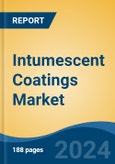Cellulosic is the fastest growing segment, Asia-Pacific is the largest regional market
Speak directly to the analyst to clarify any post sales queries you may have.
10% Free customizationThis report comes with 10% free customization, enabling you to add data that meets your specific business needs.
Key Market Drivers
The continued global emphasis on stringent fire safety regulations and evolving building codes constitutes a primary driver for the intumescent coatings market, as these mandates necessitate advanced fire protection in various structures. For instance, according to the National Fire Protection Association, the 2024 edition of NFPA 101, the Life Safety Code, introduces essential updates that redefine building design and occupant protection, mandating enhanced strategies for carbon monoxide detection and explicitly permitting alternative care sites when specific safety requirements are met. Simultaneously, the expanding global construction and infrastructure development provides a fertile ground for market growth. Significant investments in new commercial, residential, and industrial projects worldwide directly increase the demand for passive fire protection solutions. According to the Associated General Contractors of America, construction spending in the United States increased by 8.7 percent between March 2023 and March 2024, demonstrating sustained activity that fuels the need for these specialized coatings.Key Market Challenges
The inherent high formulation cost of intumescent coatings, alongside the volatility in raw material prices, significantly impedes market expansion. These specialized materials require specific chemical compounds, such as epoxy resins, flame-retardant additives, and specialized curing agents, which are often expensive to procure. Fluctuations in the prices of these crucial raw materials, influenced by global supply chain disruptions and broader economic factors, directly translate into higher manufacturing costs for producers.For instance, while some raw material prices for the broader paint and coatings sector saw an 8% decrease in the Producer Prices Index during the first two months of 2024 compared to the previous year, according to the British Coatings Federation, higher prices persisted for certain pigments and containers, indicating ongoing specific cost pressures within the supply chain. This elevated and unpredictable cost structure ultimately results in higher end-user prices for intumescent coatings. This pricing dynamic can constrain their adoption, particularly in cost-sensitive applications or regions where budget limitations necessitate more economical fire protection alternatives, thus hampering the overall growth of the market.
Key Market Trends
The Global Intumescent Coatings Market is experiencing a notable shift towards sustainable water-based formulations, driven by escalating environmental regulations and a growing industry focus on ecological responsibility. These water-based products offer reduced volatile organic compound emissions and enhanced safety during application, aligning with global green building initiatives.According to the Indian Ministry of Statistics and Programme Implementation, the construction sector grew by 10.7% in the fiscal year 2023-2024, indicating a robust market for water-based coatings within a key end-use segment for intumescent products. This sustained demand is prompting manufacturers to invest in expanding their capacity for these environmentally friendly solutions, for example, in March 2024, AkzoNobel announced the expansion of its water-based coatings production facility in China, aiming to cater to the increasing demand in the Asia-Pacific region. This trend underscores a broader commitment to more sustainable material choices in passive fire protection.
Key Market Players Profiled:
- 3M Company
- Akzo Nobel N.V.
- Contego International Inc.
- Hempel A/S
- Isolatek International
- Jotun A/S
- Nullifire Ltd
- PPG Industries, Inc.
- Rudolf Hensel Gmbh
- Sika AG
Report Scope:
In this report, the Global Intumescent Coatings Market has been segmented into the following categories:By Type:
- Water Based
- Solvent Based
- Epoxy Based
By Application:
- Hydrocarbons
- Cellulosic
By End Use:
- Construction
- Oil and Gas
- Automotive
- Others
By Region:
- North America
- Europe
- Asia-Pacific
- South America
- Middle East & Africa
Competitive Landscape
Company Profiles: Detailed analysis of the major companies present in the Global Intumescent Coatings Market.Available Customizations:
With the given market data, the publisher offers customizations according to a company's specific needs. The following customization options are available for the report.Company Information
- Detailed analysis and profiling of additional market players (up to five).
This product will be delivered within 1-3 business days.
Table of Contents
Companies Mentioned
The companies profiled in this Intumescent Coatings market report include:- 3M Company
- Akzo Nobel N.V.
- Contego International Inc.
- Hempel A/S
- Isolatek International
- Jotun A/S
- Nullifire Ltd
- PPG Industries, Inc.
- Rudolf Hensel Gmbh
- Sika AG
Table Information
| Report Attribute | Details |
|---|---|
| No. of Pages | 184 |
| Published | November 2025 |
| Forecast Period | 2024 - 2030 |
| Estimated Market Value ( USD | $ 1.32 Billion |
| Forecasted Market Value ( USD | $ 1.77 Billion |
| Compound Annual Growth Rate | 5.0% |
| Regions Covered | Global |
| No. of Companies Mentioned | 11 |









